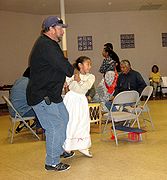
Photograph courtesy of the Nature Conservancy website
Chris Hise, Director of the Four Canyons Preserve will be taking us for a tour of the back roads and fascinating and unusual spots in the preserve, a rugged and rural spot in north western Oklahoma. On the edge of the preserve are shinnery oak. I find these particularly interesting as they spread underground from rhizomes and are rarely any taller than four feet turning into beautfiul thickets of red vegetation in the fall.
http://en.wikipedia.org/wiki/Quercus_havardii
Quercus havardii (common names include shinnery oak, shin oak and Havard oak) is a deciduous, low-growing, thicket-forming shrub that occupies some 2 to 3 million ha in the southern Great Plains of North America.[2] Clones may reach hundreds to thousands of years old, although aboveground stems typically live only 11 to 15 years. Shinnery oak stems are usually 1-2 m tall and codominate the plant community with mid- and tall-grasses which are usually taller than the oaks.
Form: A low shrub to 2 m or occasionally a small tree, Q. havardii forms large clonal thickets by extending rhizomes through the sandy soil where it is usually found.[4] Rhizomes range from 3-15 cm in diameter and are concentrated in upper 60 cm of soil, although penetration depths of 9 m has been reported. Lateral roots and woody rhizomes are widespread near the soil surface. Ninety percent or more of shinnery oak's biomass is under ground, and fortuitous root grafting is common. These underground stems commonly spread to form plants 3 to 15 m or more in diameter. Single clones are reported to cover up to 81 ha and to achieve ages over 13,000 years.[2]
The Conservancy's Four Canyon Preserve encompasses 4,000 acres of mixed-grass prairie, rugged canyons, and floodplain along the Canadian River in southern Ellis County. Scenic prairie ridges traverse the landscape, dissected by deep chinquapin oak-lined canyons draining to the river. These prairies provide habitat for a number of rare grassland birds, such as Cassin's sparrow and Swainson's hawk, and additional species of concern including reptiles like the Texas horned lizard, as well as numerous state-rare plants. The cool, wooded canyons stand in contrast to the surrounding prairies, and provide habitat for birds like red-bellied woodpecker and painted bunting. The Canadian River on the preserve provides habitat for the federally endangered least tern, the threatened Arkansas River shiner, as well as stopover habitat for migratory shorebirds including the sandhill crane.
Biodiversity Threats in the area include habitat fragmentation and loss, invasive plant species such as eastern redcedar, saltcedar, and old world bluestem, hydrologic alteration, and incompatible land management practices.
What the Conservancy is doing now will restore ecological function and integrity to this landscape. Following an initial rest period, prescribed fire will be used to control the spread of invasive eastern redcedar and to manage the habitat for wildlife. Efforts are underway to remove exotic plants such as old world bluestem from native prairie areas and to clear saltcedar from the Canadian River floodplain.
In time, the Conservancy will work cooperatively with other area landowners to conduct prescribed burns aimed at enhancing prairie habitat across the region. The critical habitat in and around the Four Canyon Preserve is home to one of Oklahoma's last remaining populations of the imperiled lesser prairie chicken. Successful management for this species will help sustain healthy populations of some of North America's most threatened grassland birds.
The Nature Conservancy is working hard and partnering with others to preserve the biodiversity of the mixed grass prairie and the shortgrass prairie. Chris Hise will tell us all about their conservation efforts in this unique habitat.





















